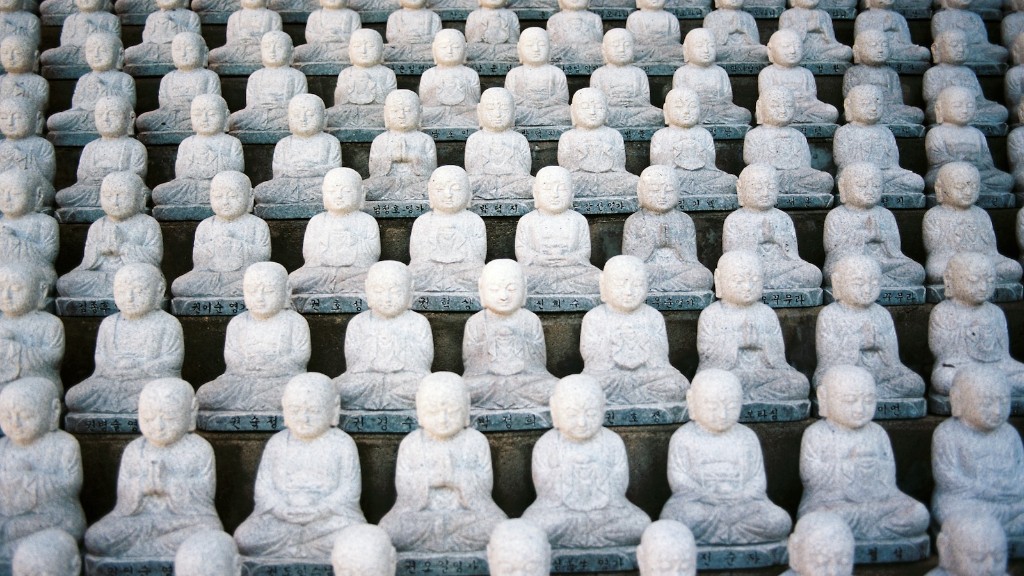Buddhism is a religion that was founded by Siddhartha Gautama in the sixth century BCE. The main goal of Buddhism is to end suffering and reach nirvana, which is a state of complete peace and annihilation of the self. There are many different paths that one can take to reach nirvana, but the most important thing is to have the right mindset and to live in the present moment.
The path to nirvana is through the Noble Eightfold Path. This path includes right view, right resolve, right speech, right action, right livelihood, right effort, right mindfulness, and right concentration.
How does a Buddhist reach nirvana?
Buddhists believe that the human life is one of suffering, and that meditation, spiritual and physical labor, and good behavior are the ways to achieve enlightenment, or nirvana. Nirvana is a state of complete bliss, freedom, and peace. Once a person has attained nirvana, they are released from the cycle of birth and death.
The Eightfold Path is a set of guidelines for living a moral and ethical life. It is also a path to spiritual enlightenment. The eight practices are: right view, right resolve, right speech, right conduct, right livelihood, right effort, right mindfulness, and right samadhi.
What are the 4 stages of nirvana
The four stages are Sotāpanna (stream-enterer), Sakadāgāmi (once-returner), Anāgāmi (non-returner), and Arahant.
Sotāpanna is the first stage, where one has entered the stream and is guaranteed not to fall back into lower realms.
Sakadāgāmi is the second stage, where one has returned once and is guaranteed not to return more than once.
Anāgāmi is the third stage, where one has attained nirvana and is guaranteed not to be reborn into any realm.
Arahant is the fourth and final stage, where one has attained complete liberation and is beyond all suffering.
Achieving nirvana on one’s own is the highest achievement a Buddhist can attain. Those who achieve this state of enlightenment are known as buddhas, or awakened ones. This is different from “the Buddha,” the specific buddha who was incarnated as Siddhartha.
What does nirvana feel like?
Nirvana is a state of complete bliss, freedom from suffering and rebirth. In Buddhism, it is the goal of the spiritual path.
Nirvana is attained when the mind is transformed and freed from negative mental states such as greed, hatred and delusion. The mind becomes peaceful, joyful and non-reactive.
The attainment of nirvana in this life is believed to result in a transformed mind with qualities such as happiness, freedom from suffering, peacefulness and non-reactiveness.
Nirvana is a state of perfect peace and bliss. Achieving it will probably not be easy, but it is worth striving for. Even if it feels impossible, keep trying. You may not achieve Nirvana overnight, but if you keep working at it, you will eventually reach a state of perfect peace and bliss.
How do you know if you have reached nirvana?
Nirvana is the highest state that a person can achieve, according to Buddhist tradition. Once a person has attained Nirvana, they will be free from all worldly desires and suffering. They will also be free from the Wheel of Life, or Bhavachakra.
Nirvana is often misinterpreted as a state of bliss or heaven that can be reached after death. However, it is more accurately a state of liberation from the cycle of rebirth. In order to achieve Nirvana, one must let go of all attachment to worldly things and realize that everything is transient. This includes attachments to the ego, which is the root of all suffering. Once the ego is released, one experiences true freedom and peace.
Can females reach nirvana
The focus of practice in Buddhism is primarily on attaining Arhatship, which is a state of enlightenment attained through moral and spiritual development. The Pali Canon, which is a major Buddhist scripture, has examples of both male and female Arhats who attained nirvana.
In Buddhism, parinirvana refers to the nirvana that occurs after death, for someone who has attained nirvana during their lifetime. This is a release from the cycle of rebirth, karma, and suffering. The skandhas, or the Five Aggregates that make up a person’s being, are also dissolved upon parinirvana.
What are the 5 hindrances to nirvana?
The five hindrances are sensual desires, ill will, apathy & laziness, anxiousness and doubt. They are the main obstacles to our spiritual development and growth. If we can overcome them, we will be able to progress on the path to enlightenment.
In Buddhism, it is believed that life is suffering. The ultimate goal is to end the cycle of suffering, which includes the cycle of repeated death and rebirth. The achievement of this goal is called nirvana.
Can anyone become enlightened in Buddhism
The path to enlightenment is open to all beings, regardless of their station in life. The Buddha himself was an ordinary man who attained enlightenment through his own efforts, and it is said that any being can do the same. In Theravada Buddhism, enlightened beings who are not the Buddha are known as arhats, or worthy ones. In Mahayana Buddhism, all beings are already inherently enlightened but have yet to realize it. Enlightenment is a matter of recognizing one’s true nature and letting go of the false beliefs and attachments that keep us trapped in the cycle of birth and death.
The Buddha declared that once stream-entry has been reached, full enlightenment is guaranteed within a minimum of seven lifetimes. This means that once a person has attained stream-entry, they will be able to achieve full enlightenment within seven lifetimes at most. This is an incredible assurance and shows the great power of the Buddha’s teachings.
How to become enlightened Buddhism?
Buddhists believe in following the Middle Way, which is the path that lies between two extremes. This means that one should neither live a life of luxury and ease, nor a life of poverty and hardship. Instead, they should find a middle ground where they can be content and at peace.
The main characteristics of enlightenment, as identified by Bucke, are joyfulness, a profound connection with the universe, a sense of immortality, a deep satisfaction that they now had direct knowledge of life’s mysteries, and a sense of being in the light. These characteristics are all indicative of a deep understanding and acceptance of the world around us, and a sense of peace and contentment with our place in it. Enlightenment is a state of being that we can all strive for, and one that can bring great happiness and satisfaction to our lives.
Final Words
In order to reach nirvana, Buddhists must follow the Noble Eightfold Path. This path involves right understanding, right thought, right speech, right action, right livelihood, right effort, right mindfulness, and right concentration. By following this path, Buddhists believe that they can end their cycle of rebirth and attain nirvana.
In order to reach nirvana, Buddhists must follow the Noble Eightfold Path. This path includes right understanding, right thought, right speech, right action, right livelihood, right effort, right mindfulness, and right concentration. by following this path, Buddhists can reach a state of nirvana, which is a state of perfect peace and enlightenment.




